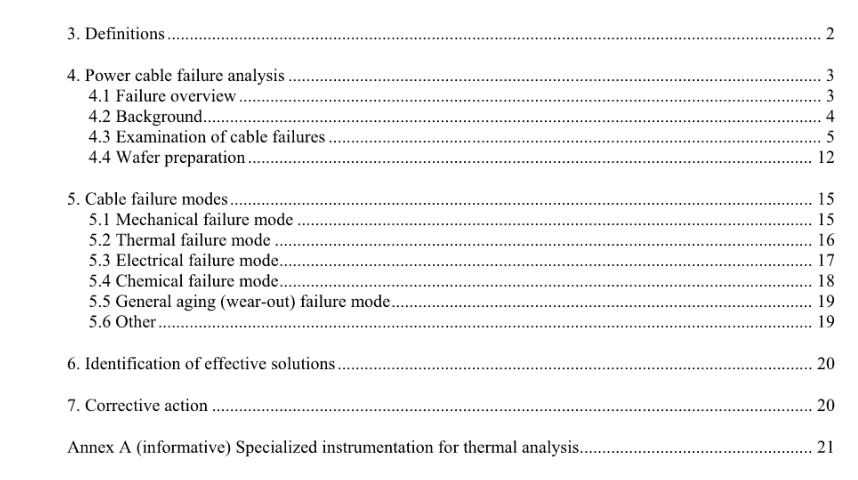IEEE 1511.1-2010 pdf download.IEEE Guide for Investigating and Analyzing Shielded Power Cable Failures on Systems Rated 5 kV Through 46 kV
4. Power cable failure analysis
4.1 Failure overview
This overview is intended to help the user formulate a perspective of what constitutes a cable failure. It is not uncommon for users to classify failures in general terms, such as manufacturing defects, water trees, etc. However, this thought process does not help determine the root cause(s) of failure and appropriate corrective actions to prevent future failures.
An energized cable failure occurs when current flows outside the intended conductors, usually to ground, along a path through the cable wall that results in a permanent short to ground. An unenergized cable failure occurs when a cable is physically damaged by a mechanical force and results in a penetration through all or most of the cable wall.
It is important to remember that a cable failure may have multiple contributing factors, but a single root cause. A complete failure analysis must systematically investigate all contributing factors to determine the root cause. This investigation must include the following:
-Cable component materials
-Cable design
-Cable manufacturing processes
-Cable system design
-Cable system installation
-Operating practice
-Operating environment
-Cableage.
When analyzing a failure, this approach will assist in determining if the failure is an“abnormal event” or “general aging.” When the root cause is identified, the opportunity to reduce future failures and improve system reliability will likely be established. The cable failure sample must be collcted without contaminating the sample. The sample must be a complete segment of cable, including the faulted area.
A description of the surrounding environment must also be included. When a cable failure is retumned from the field, its quality can range from a reasonably clean sample with a small hole to a muddy, burnt-up carcass. The muddy burnt-up carcass contains valuable information that must remain intact to provide useful information in the failure analysis, much the same as a forensics investigator will tape off a burned house until the initial gathering of evidence is complete. As soon as the failure is removed in the field, it should be wrapped in plastic and protected during shipping and handling until it is provided to the individual who will be doing the failure analysis. This careful treatment will greatly increase the odds of determining a cause of failure.
4.2 Background
The cables used to transport electric power operate over a wide range of voltage and current ratings. These cables operate in a range of environments that include, but are not limited to, the following:
In dry deserts
-Surrounded by fire proofing materials
-In cable trays exposed to radiation
-n bright sunlight at the top of riser shields
-Within conduits flled with water
-Direct-buried in the earth
-Under rivers and scas
With this range of environments, a variety of cable types are required that utilize special design features and insulations optimized to meet the application requirements. The cables addressed in this guide are restricted to shielded power cables. The guide covers the following insulation types:
-Natural rubber
-Styrene butyl rubber (SBR)
-High molcular weight polyethylene (HMWPE)
-Cross-linked polyethylene (XLPE)
-Ethylene propylene rubber (EPR)
-Tree retardant cross-inked polyethylene (TRXLPE).IEEE 1511.1 pdf download.IEEE 1511.1-2010 pdf download
IEEE 1511.1-2010 pdf download

Leave a Reply